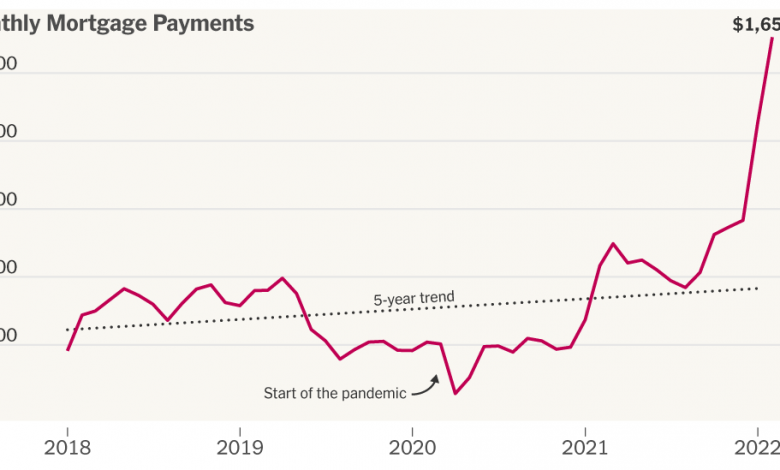Can Home Prices and Interest Rates Soar at the Same Time?

It’s getting more expensive by the moment to buy a home in America. Mortgage interest rates, historically low during most of the pandemic, are rising faster than they have in decades.
Put the two trends together, and the impending monthly mortgage payment for home buyers — combining principal and interest payments — is really taking off:
In February, according to the Mortgage Bankers Association, the median monthly payment on a new mortgage application in America jumped more than 8 percent in just one month. That spike, shown above, points to an entirely new and unpredictable phase in what has been a jaw-dropping housing market.
In normal times, rising mortgage rates are supposed to help cool housing prices. But it’s possible for now that both measures will keep charging ahead together, making it increasingly expensive to buy a home.
“There are so many strange things going on right now,” said Edward Seiler, the associate vice president for housing economics at the Mortgage Bankers Association.
Understand Inflation in the U.S.
It has been 40 years since rates have risen like this alongside similar home price growth and high inflation. This time around, the United States also has a severe housing shortage. And then there’s a new and uncertain dynamic — the sudden rise of working from home, which has the potential to change what home buyers want and where they live.
“Nobody really knows what’s going to happen over the next year,” Mr. Seiler said. That makes it hard to predict when rates might start to act as a brake on rising prices.
Among a subset of mortgages backed by Freddie Mac, the monthly payment new buyers are making has risen more steeply since the start of the pandemic than at any time in the last 25 years.
“That shows you the compounding artifact of both rising rates and rising home prices,” said Sam Khater, the chief economist at Freddie Mac. “We’ve had episodes of each in the past — but not this intense for both.”
Early in the pandemic, falling mortgage rates enabled rising home prices — and offset them in monthly mortgage payments that remained steady through much of 2020. But with both measures rising at the same time, monthly payments can escalate quickly, as they have in Sun Belt and Mountain West states in particular.
Rates and home prices could well continue rising together for a number of reasons tied to high inflation today. Rents are soaring now, too. That means the alternative to buying isn’t particularly appealing, either. And in a time of high inflation, buying a home — and locking in today’s monthly payment for the next 30 years — is a good way to shield yourself from rising rents. In a context of 8 percent annual inflation, a 4.5 percent mortgage interest rate is actually a decent deal.
For would-be home buyers, “the alternative is both the rental option, as well as the option of where do you put your money?” said Arpit Gupta, a professor at N.Y.U.’s Stern School of Business. During past periods of high inflation, real estate has tended to be a better asset than other kinds of investments like stocks (and better than leaving money in a checking or savings account).
Mr. Gupta warns that rising rates can also make rental inflation even worse, because it pushes more people out of the buyer market and into the rental market, driving demand there. In a kind of feedback loop, those ever-rising rents will also continue to put pressure on people who can afford to buy instead, even at higher interest rates.
So far, as mortgage rates have risen half a point in the last four weeks, there’s little evidence the market is calming. In the past month, the share of for-sale homes accepting an offer within just one week reached a record, and list prices in the past week are still setting new highs.
Inflation F.A.Q.
What is inflation? Inflation is a loss of purchasing power over time, meaning your dollar will not go as far tomorrow as it did today. It is typically expressed as the annual change in prices for everyday goods and services such as food, furniture, apparel, transportation and toys.
“I don’t see a lot of concern from my buyers,” said Beth Abeita, a Redfin real estate agent in Austin, Texas, where home prices rose an astounding 30 percent in 2021. If anything, she said, she hears people worried about the stock market, not mortgage rates — both because they now believe housing will be a better investment, as Mr. Gupta suggested, and because lower stock prices mean some buyers will have less money for a down payment.
There’s a logic to going all-out in bidding for scarce housing right now before it gets worse, Ms. Abeita said.
“Interest rates are not going to rise any longer for you,” she said of those who have secured a house. “You’re not going to pay even higher prices in three months. What you think you’re overpaying for today will be a deal in a few months because everything is increasing so rapidly.”
That touches on another reason that demand probably isn’t cooling yet: The expectation of higher rates to come may drive a surge in buyers trying to get ahead of them now.
In this environment, buyers are also still competing for historically tight supply. The inventory of homes for sale has been at record lows, with more owners holding onto homes as rental investments instead of selling them, and with potential sellers who are afraid they won’t find their next home not entering the market. Higher rates will probably deter some sellers, too, as they choose to stay put in a home recently refinanced at rock-bottom rates rather than move to a new home at an interest rate twice as high.
Exacerbating all of these challenges, there has been underbuilding in the U.S. for years, particularly in expensive coastal metros where housing is in high demand.
“Higher rates don’t solve any of that,” Mr. Khater said. “It might bring the market a little more in balance — modestly more in balance — but it doesn’t solve the fundamental issue.”
Higher rates, in other words, won’t create more supply. If anything, rising rates across the economy will increase borrowing costs for homebuilders, too, on top of all their other pandemic problems.





